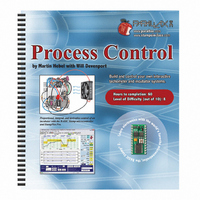122-28176 Parallax Inc, 122-28176 Datasheet - Page 221

122-28176
Manufacturer Part Number
122-28176
Description
GUIDE STUDENT PROCESS CONTROL
Manufacturer
Parallax Inc
Specifications of 122-28176
Accessory Type
Manual
Product
Microcontroller Accessories
Lead Free Status / RoHS Status
Contains lead / RoHS non-compliant
For Use With/related Products
Propeller Education (PE) Kit
Lead Free Status / RoHS Status
Lead free / RoHS Compliant, Contains lead / RoHS non-compliant
- Current page: 221 of 330
- Download datasheet (11Mb)
ACTIVITY #4: OPEN LOOP PWM CONTROL
The simplest form of process control is open loop. The block diagram in Figure 6-21
represents a basic open-loop system.
actuator. The calibrated setting on the actuator determines how much energy is applied.
The process uses this energy to change its output. Changing the actuator’s setting changes
the energy level in the process and the resulting output. If all of the variables that may
affect the outcome of the process are steady, the output of the process will be stable.
The fundamental concept of open-loop control is that the actuator’s setting is based on an
understanding of the process. This understanding includes knowing the relationship of the
effects of the energy on the process and an initial evaluation of any variables disturbing
the process. Based on this understanding, the output “should” be correct. In contrast,
closed-loop control incorporates an on-going evaluation (measurement) of the output, and
actuator settings are based on this feedback information.
Consider the temperature control process shown in Figure 6-22. The fluid being drawn
from the tank must be kept at constant temperature. Obviously, this will require adding a
certain amount of heat to the fluid. (The drive on the transistor determines the power
delivered to the heating element.) The question becomes “How much heat is necessary?”
Energy is applied to the process through an
Figure 6-21
Open-Loop Block
Diagram
Related parts for 122-28176
Image
Part Number
Description
Manufacturer
Datasheet
Request
R

Part Number:
Description:
MANUAL FOR SUMOBOT
Manufacturer:
Parallax Inc
Datasheet:

Part Number:
Description:
GUIDE STUDENT SMART SENSORS
Manufacturer:
Parallax Inc
Datasheet:

Part Number:
Description:
MANUAL PROPELLER
Manufacturer:
Parallax Inc
Datasheet:

Part Number:
Description:
LEAD WIRES FLYING CABLE III/IV
Manufacturer:
Xilinx Inc
Datasheet:

Part Number:
Description:
BOARD ADAPTER AND FLY LEADS
Manufacturer:
Xilinx Inc
Datasheet:

Part Number:
Description:
PLATFORM CABLE USB II
Manufacturer:
Xilinx Inc
Datasheet:

Part Number:
Description:
KIT STARTER COOLRUNNER-II BUNDLE
Manufacturer:
Xilinx Inc
Datasheet:

Part Number:
Description:
Microcontroller Modules & Accessories DISCONTINUED BY PARALLAX
Manufacturer:
Parallax Inc

Part Number:
Description:
Microcontroller Modules & Accessories DISCONTINUED BY PARALLAX
Manufacturer:
Parallax Inc

Part Number:
Description:
BOOK UNDERSTANDING SIGNALS
Manufacturer:
Parallax Inc
Datasheet:

Part Number:
Description:
BOARD EXPERIMENT+LCD NX-1000
Manufacturer:
Parallax Inc
Datasheet:

Part Number:
Description:
IC MCU 2K FLASH 50MHZ SO-18
Manufacturer:
Parallax Inc
Datasheet:












